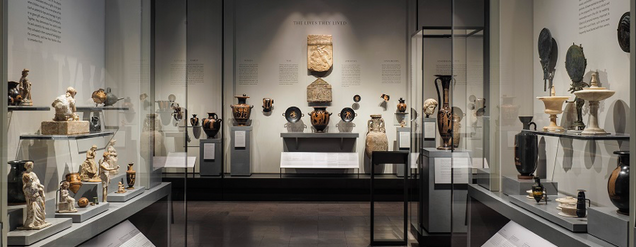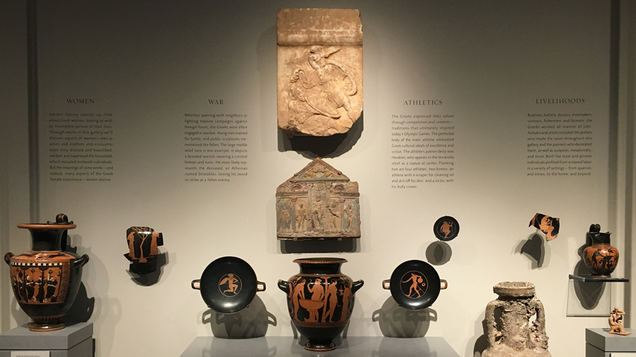Everyday Extravagance: Displaying the Art of Greek Daily Life at the Museum of Fine Arts, Boston

Life in Ancient Greece Gallery at the Museum of Fine Arts, Boston. (Photograph © Museum
of Fine Arts, Boston).
Three years after opening the innovative galleries devoted to Greek epics, theater, and the symposium, the Museum of Fine Arts, Boston (MFA) debuted another permanent installation of 250 additional objects from its robust collection of antiquities.[1]The spacious gallery, Daily Life in Ancient Greece, prompts visitors to engage with the remarkable material culture of Greek day-to-day life rather than mythological representations (fig. 1). Many artifacts on display, such as a surgeon’s toolkit, a child’s articulated doll, a model barbershop, and a scene of female athletes bathing, contribute to a narrative of individual experiences and reflect quotidian aspects of ancient Mediterranean society that have remained largely unexamined within both academic and curatorial spheres.
As curators of the new installation, Dr. Christine Kondoleon, the George D. and Margo Behrakis Senior Curator of Greek and Roman Art, and Dr. Phoebe Segal, the Mary Bryce Comstock Curator of Greek and Roman Art, employed modes of display which elucidate rather than obscure the intricacies and ambiguities of everyday objects. Rows of parallel cases present the interrelated familial themes of livelihood, domestic activity, childhood, and mourning, and at the rear of the gallery, a perpendicular display devoted to the communal subjects of competitive athletics and military training disrupts the preceding arrangement. The writers of the present article, who served as graduate research interns for the gallery, investigated examples of the extraordinary artistic expressions that permeated each of the various categories of Greek culture represented. We present the results of our work along with an interactive exhibition graphic, which preserves the object relationships established by novel gallery design and enhances the interpretative narrative (fig. 2).


At the entrance to the gallery, the interior of a drinking cup (kylix) depicts a man squatting, defecating, and wiping with a stone (fig. 3). Without household plumbing, toilet paper, or soap, this would have been a common sight.[2]Painted images on vessels of defecating, urinating, or vomiting men, appearing frequently between 530 and 470 BCE, portray intoxicated revelers relieving themselves after a heavy night of drinking.[3]Wine concealed these internal decorations, which only came to light as the cup was emptied. Designed to take drinkers by surprise, such jokes or visual puns warned of the consequences of drunkenness and excessive indulgence.[4]

Another kylix portrays a satyr chiseling the vertical grooves into a column between his legs (fig. 4).
A wineskin in the background suggests he is perhaps already inebriated, possibly sneaking drinks throughout the day as would befit the uninhibited lifestyle of a satyr. The cup’s user would have recognized the phallic column, and the implied joke, “working with the hand” or “handiwork”, references masturbation.[5] The unexpected scenes impose upon museum audiences the commonplace obscenities and excesses of the typical drinking parties enjoyed by elite Greek men.

A more somber moment appears on a monumental marble replica of a lekythos,or oil jar, dated to around 390 BCE (fig. 5). Dedicated as a tomb marker for a woman named Nikagora, its iconography conforms to the standard language of Greek funerary monuments, but the state of its surviving painted decoration, commonly referred to as polychromy, sets this gravestone apart.[6]Bands of geometric designs frame the main pictorial scene, represented in relief, and tendrils of vegetal decoration curl along the vessel’s shoulder and climb its high neck. Viewed with the naked eye, the preserved pigmentation appears dull and muted. However, after the conservation team employed the use of infra-red and ultraviolet light in addition to digital x-radiography, the vessel lit up with traces of color. The enhanced images reveal previously invisible pigment: slender triangles in Egyptian blue encircle the lower register, one woman’s garment was originally an eye-catching shade of yellow, and red iron oxide was liberally employed. This lekythos imparts an important, and often forgotten, reality of the ancient lived experience: vibrant color was everywhere.

Opposite the remembrance and mourning displays, an assemblage of artifacts related to the Greek military recognizes the impact of frequent warfare on the lives of citizen-soldiers (fig. 6). The works selected range from battle-worn arms and armor to vases depicting individual warriors bidding their families ceremonial farewells. A convex shield produced in the second half of the sixth century BCE measures 82 centimeters in diameter, but its decoration was restricted to minute figural reliefs on the bronze arm strap attached to the reverse. The sole surviving scene that is identifiable depicts a woman consoling a grieving hero (fig. 7). Through an analysis of comparable small-scale artworks, this iconography closely corresponds to portrayals of the grief-stricken warrior Achilles met by his mother, Thetis, who would procure a set of armor for him.[7]Visible only to the infantryman holding the shield, such images construed the personal experiences of war and reflected the reality that each citizen-soldier’s family supplied their arms.
In Daily Life in Ancient Greece, surprises abound within the general vision of the daily experience of the ancient Greeks. Discovering the timing of visual puns within wine cups, the vibrancy of a well-adorned and colorful tomb marker, and the self-referential imagery behind an imposing shield reveal continuity in the artistry found throughout everyday objects. The multifaceted layers of the lives on display bring visitors to the gallery beyond the ordinary and into the extra-ordinary.

Bailey Benson, Steve Burges and Carlos Muñoz
Special thanks to Mike Tom, Department of Public Relations, Museum of Fine Arts, Boston
_______________________________________________________________________________________
[1]The Wine, Poets, and Performers in Ancient Greece Galleries are rooms 215A-C in the MFA, and the new Daily Life in Ancient Greecegallery spans rooms 212A-B, abutting the Michael C. Ruettgers Gallery for Ancient Coins in room 212C.
[2]John K. Papadopoulos, “Παιζω η χεζω? A contextual approach to pessoi (gaming pieces, counters, or convenient wipes?),” Hesperia71 (2002): 423-427.
[3]Alexander G. Mitchell, Greek Vase-Painting and the Origins of Visual Humour(Cambridge: Cambridge University Press, 2009): 90-91.
[4]Ibid.
[5]Ibid., 195-96.
[6]Mary Comstock and Cornelius Vermeule, Sculpture in Stone: The Greek, Roman, and Etruscan Collections of the Museum of Fine Arts, Boston (Boston: The Museum of Fine Arts, 1976), 51.
[7]Close comparisons are found in Etruscan depictions of “Achle,” such as the British Museum gem of the first half of the fifth century (1867,0507.414) where the hero, who is labeled, takes a very similar pose. (Leonard Muellner, “Grieving Achilles,” in Homeric Contexts: Neoanalysis and the Interpretation of Oral Poetry, eds. Franco Montanari, Antonios Rengakos, and Christos Tsagalis, 197-220 (Boston: De Gruyter, 2012): 198-205.)